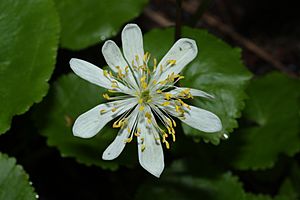White marsh marigold facts for kids
Quick facts for kids White marsh marigold |
|
|---|---|
 |
|
| Caltha leptosepala subsp. howellii | |
| Scientific classification | |
| Genus: |
Caltha
|
| Species: |
leptosepala
|
| Subspecies and varieties | |
|
|
| Synonyms | |
|
C. lasopetala, C. leptostachya, C. chelidonii, C. uniflora |
|
The Caltha leptosepala, also known as the white marsh marigold, is a type of flowering plant. It belongs to the buttercup family. This plant grows naturally in western North America. You can find it from Alaska all the way down to New Mexico. It likes to grow in wet, mountainous areas. These areas are often in very high places, like alpine and subalpine regions. There are two main kinds of this plant in the wild. One grows inland, and the other grows along the Pacific coast.
What Does the White Marsh Marigold Look Like?
This plant is a perennial herb. This means it lives for more than two years. It grows a stem that is mostly bare. Its leaves grow mainly from the bottom of the plant. These leaves can be up to 13 or 15 centimeters long. Their edges can be smooth, wrinkled, or even toothed.
The plant produces one or more flowers. Each flower is about 1 to 4 centimeters wide. Interestingly, these flowers do not have true petals. Instead, they have sepals that look like petals. These sepals are usually white. Sometimes, they can be yellow. In the middle of the flower, you will see many long, flat stamens. There are also a few pistils.
Different Types of Marsh Marigolds
Caltha leptosepala is a complex plant. It has different forms, often called subspecies or varieties. Scientists used to group it with other Northern Hemisphere species. However, new studies show it is more closely related to species from the Southern Hemisphere.
There are two main subspecies. They are found in different parts of its range:
- ssp. howellii This type usually has one or two flowers. Their white sepals are shaped like oblong ovals. Its kidney-shaped leaves can be up to 15 cm long. They have a blunt tip. The base of the leaves often touches or overlaps. You can find this subspecies in open, marshy areas. It grows in places like the Sierra Nevada and Cascade Range. This includes California, western Nevada, Oregon, western Washington, and Vancouver Island.
- ssp. leptosepala var. leptosepala This type typically has one flower. Its white sepals are long and narrow. The leaves are heart-shaped and up to 7 cm long. They have a blunt or pointed tip. The base of the leaves does not touch. This variety grows in open, marshy alpine and subalpine spots. It is found in the Rocky Mountains. This includes parts of Arizona, Colorado, Idaho, Montana, Nevada, Utah, and Wyoming.
- ssp. leptosepala var. sulphurea This variety is very similar to the one above. The main difference is that its sepals are yellow instead of white. It also grows in wet alpine and subalpine meadows. You can find it in the Rocky Mountains of Montana and Idaho.
Can You Eat It?
Elk are known to eat the leaves of this plant. However, the plant contains some toxic substances called alkaloids.
Some of the native people in Alaska used to eat the leaves and flower buds.


